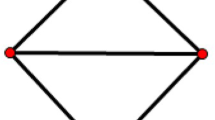Abstract
The notion of superhigh computably enumerable (c.e.) degrees was first introduced by (Mohrherr in Z Math Logik Grundlag Math 32: 5–12, 1986) where she proved the existence of incomplete superhigh c.e. degrees, and high, but not superhigh, c.e. degrees. Recent research shows that the notion of superhighness is closely related to algorithmic randomness and effective measure theory. Jockusch and Mohrherr proved in (Proc Amer Math Soc 94:123–128, 1985) that the diamond lattice can be embedded into the c.e. tt-degrees preserving 0 and 1 and that the two atoms can be low. In this paper, we prove that the two atoms in such embeddings can also be superhigh.
Similar content being viewed by others
References
Cooper S.B.: Degrees of unsolvability complementary between recursively enumerable degrees I. Ann. Math. Logic 4, 31–73 (1972)
Downey R.: D.r.e. degrees and the nondiamond theorem. Bull. Lond. Math. Soc. 21, 43–50 (1989)
Epstein, R.L.: Minimal degrees of unsolvability and the full approximation construction. Mem. Amer. Math. Soc., 162(3), (1975)
Jockusch C.G. Jr, Mohrherr J.: Embedding the diamond lattice in the recursively enumerable truth-table degrees. Proc. Amer. Math. Soc. 94, 123–128 (1985)
Lachlan A.H.: Lower bounds for pairs of recursively enumerable degrees. Proc. Lond. Math. Soc. 16, 537–569 (1966)
Martin D.: Classes of recursively enumerable sets and degrees of unsolvability. Z. Math. Logik Grundlag. Math. 12, 295–310 (1966)
Mohrherr J.: A refinement of low n and high n for the r.e. degrees. Z. Math. Logik Grundlag. Math. 32, 5–12 (1986)
Ng K.M.: On very high degrees. J. Symb. Logic 73, 309–342 (2008)
Simpson S.G.: Almost everywhere domination and superhighness. Math. Log. Q. 53, 462–482 (2007)
Soare R.I.: Recursively Enumerable Sets and Degrees. Springer, Heidelberg (1987)
Author information
Authors and Affiliations
Corresponding author
Additional information
Cenzer is partially supported by NSF grants DMS-0554841 and DMS-652372.
Wu is partially supported by AcRF grants RG58/06 and RG37/09 from Singapore MoE.
Rights and permissions
About this article
Cite this article
Cenzer, D., Franklin, J.N.Y., Liu, J. et al. A superhigh diamond in the c.e. tt-degrees. Arch. Math. Logic 50, 33–44 (2011). https://doi.org/10.1007/s00153-010-0198-3
Received:
Accepted:
Published:
Issue Date:
DOI: https://doi.org/10.1007/s00153-010-0198-3




